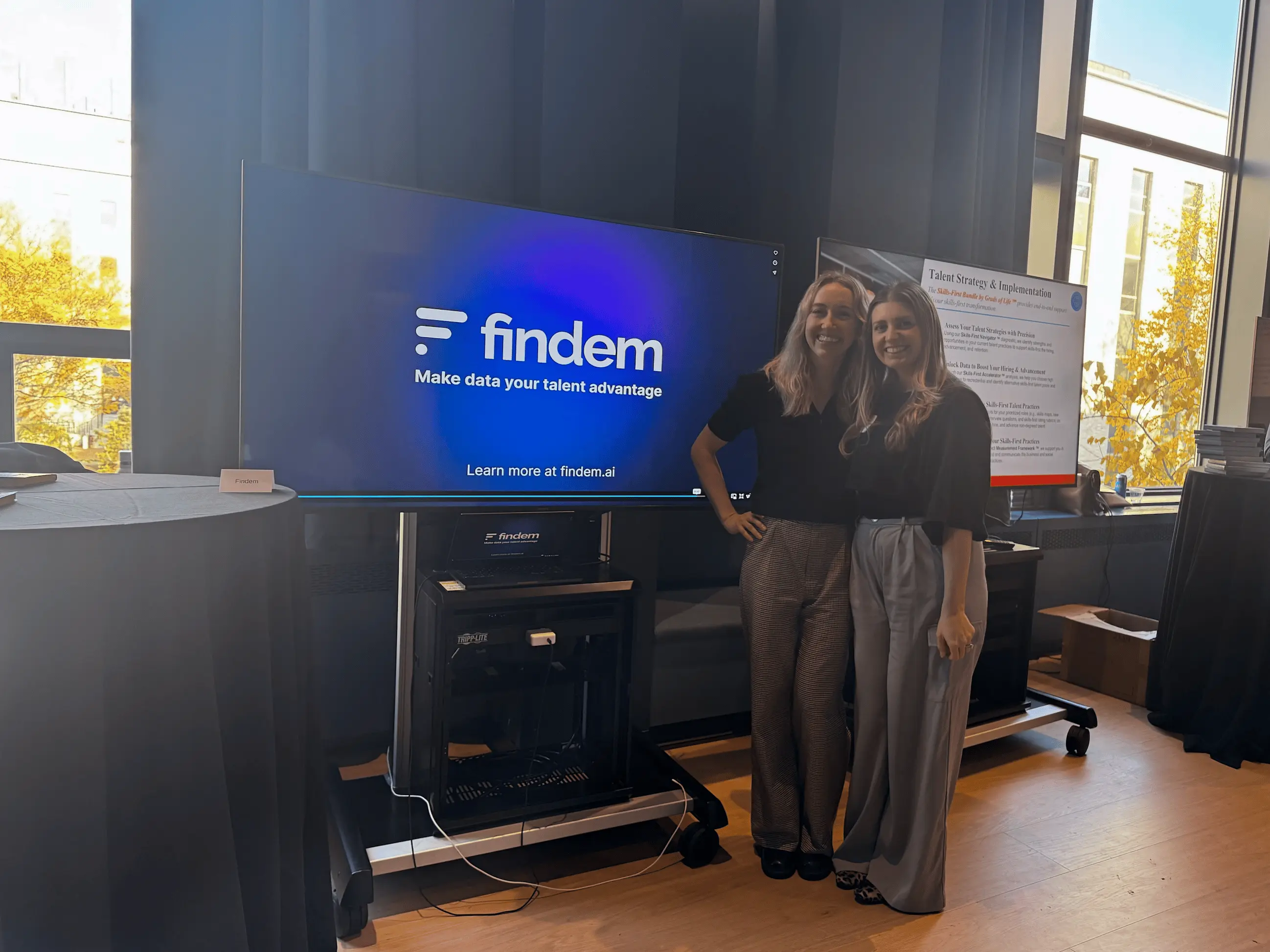.svg)
Why I joined Findem as Chief of Talent Transformation
.svg)

After an amazing 6 month rest and recharge, I'm excited to announce that I'm making an industry adjacent career transition, from leading talent acquisition teams, to leading AI-first talent strategies for Findem customers.
In this newly created position, I will be responsible for operationalizing Findem’s transformation vision. Our goal is to help innovative leaders transform their talent organizations through an AI-first mindset to operate with new levels of efficiency and effectiveness, becoming a value driver for the business.
Why talent transformation now?
The HR and Talent space has been ripe for disruption for quite some time. Strategies have long been ahead of technology capabilities, requiring multiple tools, integrations, adoption, and connecting disparate data to measure success. These strategies also required scaling up and down with people, which every TA leader knows is very challenging, expensive, and unpredictable.
With the introduction of AI and Gen AI, the opportunity is to scale with technology. It's incredibly exciting to see investment and attention focused on the people space. Talent and HR has lagged behind other departments in becoming data driven. AI creates an opportunity to elevate the overall impact of the work we do.
The vision for AI-first transformation is to automate everything that can be automated while equipping humans with the context and insights they need, to do anything that can't be automated. People are a company’s largest investment. Companies spend, on average, 70 cents of every dollar on people, and yet, the People team is often under-invested in from a headcount perspective, lacks the sophistication of tools to deliver efficiency, and is the first team hit with budget cuts during a downturn. AI will enable teams to do more, with less.
My journey to Findem
I started thinking differently about how inefficient recruiting was decades ago.
Asking the right questions
I was leading a recruiting team at Intuit, and I began to think about what I called the talent ecosystem. In meetings with business leaders on the Intuit QuickBooks team, waiting to provide the hiring update, I was fascinated by how the business built multi-channel marketing strategies aimed at gaining customers to deliver revenue today, while nurturing customers who might deliver revenue tomorrow. It was about creating and measuring demand across various channels, and using the right medium and message to connect deeply with different customer segments.
This was not how those of us in talent acquisition went to market to gain new, qualified candidates. We did reach-out, 1:1, on LinkedIn vs messaging 1:many. We posted jobs and hoped the right people applied, and reviewed referrals when employees provided them.
The business was light years ahead of us in how they approached, engaged, nurtured, and converted prospects to customers. I started thinking how could the recruiting team mimic how the business operates? Do we have the right strategy, the right people, the right skills to operate in this way? It was clear we did not and were still operating in the past.
Developing the right mindset
I began by asking my peers in marketing, sales, product, and operations how they did their jobs, and how they used data, automation, and technology. I began to understand that what they had in common was not only a “product mindset”, but a system that depended on different teams working together for one common goal.
These teams stayed focused on two things: converting customers now to meet short-term bookings and revenue goals now, while nurturing prospects to be converted later and sustain growth. They had a multi-channel, connected go-to-market strategy to grow their customer base!
We took this playbook and began to make progress. We organized a system, and invested in CRM technology. We hired a talent engagement marketing team to do outreach at scale and nurture candidate communities. But we still lacked the technology that could power every channel, and be used to identify and acquire new candidates. This was a good effort that began to change the way we operated as an organization, but there was more to do!
Becoming data-driven
Understanding the roles for which a company hires is critical to building and nurturing talent pools to generate a flywheel effect. We chose which talent pools to build by identifying the roles that we hired for over and over, approximately 70% of all hires. Then built a nurture strategy around them, which was also owned by marketers. Talent pool technology can be as simple as a shared spreadsheet on a shared drive or as complicated as the most sophisticated candidate relationship management software (CRM).
We invested in light CRM and marketing automation, and began nurturing candidates in talent pools with interactive engagements to build relationships, so that, when the right role was open and the candidate was looking to make a move, we were top of mind. In two years, we went from zero to 8% of our annual hires coming from talent pools. We essentially created a new source of talent for Okta. If we had not made hires from these talent pools, we would not have met our hiring goals.
Operationalizing the talent ecosystem
We also built out an ecosystem strategy to actively invest in sourcing candidates across all channels (inbound, referrals, alumni, talent pools, direct sourcing, contingent workforce, university, etc…), to give us the best chance at finding enough qualified talent, continuously, to reach our hiring goals.
Each channel of the ecosystem had its own, unique go-to-market strategy to create demand within the channel that would feed active talent pipelines that recruiters could plug into for open roles.
Automation, dashboards and analytics came next, so that we could measure and test channel effectiveness. Now, we were starting to look and operate like a sales and marketing organization vs a “recruiting” team. We would continuously re-allocate investment to the most productive channels, maximizing the ROI in each channel.
Automating and elevating talent teams
All the while, year after year, we faced budget constraints and technology trade offs. No single technology could solve or power candidate engagement across our full ecosystem. We did quite a bit of manual work. That takes time away from work that could be done in the future by machine. When we did find a technology, it was often a point solution and we were faced with making many different, best of breed technology decisions. It became expensive and challenging to implement, gain adoption and demonstrate analytics in a single place.
And then…..I came across Findem.ai. Not only could Findem’s platform source talent for all the ecosystem channels, it was infused with AI and Gen AI, which worked faster and at a scale we couldn’t duplicate. Findem alleviated so much manual work for recruiters, that I was amazed and began to imagine what else talent recruiters could be doing.
Before joining Findem, I described this journey and my vision during this webinar: Building a Talent Ecosystem that Scales.
Helping talent teams transform
Now that I’ve joined Findem, I’ll be able to take this vision to the next step: leading Talent Transformation and helping companies take this journey. I’m building a team to advise talent leaders on how they can run as a product business, build ecosystem level go-to-market strategies to create demand for their product (A Career at their Company), and invest in the technology to power this all-in-one platform.
This new function at Findem will help our clients operationalize an “AI-first” approach to talent. An optimized talent ecosystem and a resilient talent organization will help teams manage through both turbulence and growth.
Why I believe in Findem’s vision
Being on the front lines of talent acquisition for 20+ years, I see the opportunity for companies to transform hiring from a tactical process to a comprehensive talent ecosystem with AI and automation.
Instead of relying on LinkedIn, job postings, and individual emails to try and meet hiring goals, recruiters and talent teams will be able to elevate their role to engage talent across the talent lifecycle. This will enable talent teams to move faster, be more productive, more efficient, and build balanced pipelines across a multitude of channels with a browser and an internet connection.
As more teams realize the benefits of scale delivered through AI-infused talent pool strategies, talent organizations may begin to shift from recruiters and sourcers, to teams of recruiters, qualifiers, demand gen and loyalty marketers, and program and product managers, operating more like a “product business” than a recruiting organization.
Hari Kolam, Raghu Venkat, and Findem have delivered a generative AI driven platform that puts the power of the entire talent ecosystem in the hands of its users. The ability to execute on a multi-channel, attribute driven internal and external candidate pipeline, inclusive of simple CRM, marketing automation, and analytics is transformational in our space.
I couldn't be more excited, as the talent and HR industry has long been ripe with opportunities to improve operating efficiencies and make our jobs easier and more strategic. The AI technologies are now here, and the future is bright.
If you are a CEO, CFO, CHRO/CPO, head of talent development, head of people business partners, Head of TA, Head of People Programs, RPO, Exec Search, or RPO leader and haven’t heard of Findem and what it can do to optimize your people initiatives, you will soon.
I look forward to improving the lives of customers adopting an AI first, technology driven talent organization.










